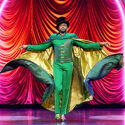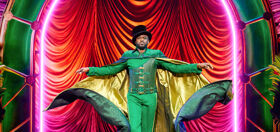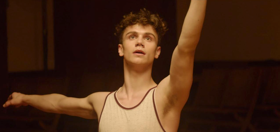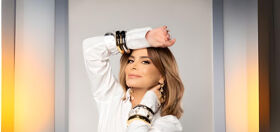
That last post’s a perfect segue into today’s installment of The Totally Frightful Issue.
So far this week we’ve looked at taxidermic hats, refuse art, a few diseases, freaky fashion trends and loads of other terrifying topics.
Today, however, we’ve got a really special post on Timothy Cummings: a gay painter whose work captures the delicate, torturous transformation from childhood to adulthood. Subverting images of innocence, death, and sexuality, Cummings creates images as sinister as they are seductive.
So, why’s this piece so special? Well, it celebrates the opening of Cummings’s new show at Nancy Hoffman Gallery here in New York.
How about we take this to the next level?
Our newsletter is like a refreshing cocktail (or mocktail) of LGBTQ+ entertainment and pop culture, served up with a side of eye-candy.
Opening October 21st (just in time for Halloween), “The Great Escape” brings the viewer back to Cummings’s dark fantasy world where costumes are the norm, horror awaits in the shadows and beguiling children stare you down.
While the viewer gets a taste of the Albuquerque-born, San Francisco-based artist’s new work, he’ll also be showing a video collaboration with Aaron Plant and Shane Francis entitled, “Iodine.”
To prepare for the show, Queerty‘s own Andrew Belonsky sat down with Cummings to pick the artists brain. The results are anything but frightful.

Andrew Belonsky: Do you start a painting with a definite idea?
Timothy Cummings: I usually start a face. Maybe there’ll be somewhat of a background, but I’ll start painting a figure, a face, and then that grows. What is the person doing? What is he wearing? And from there I kind of see what happens with that particular character. It completely grows out of a spontaneous thing. For me it’s much more enjoyable that way. I think that often makes the painting more enjoyable for other people.
AB: I read somewhere, I don’t remember where. Maybe Offbeat…
TC: Oh, God. Someone put that together – I don’t know what that was – maybe ten years ago.
AB: Well, I think there was something in that about how when you were a kid you couldn’t sleep because of the Holocaust. You said – or, it said – that your work exorcises those demons. Your work obviously deals a lot with the pubescent transformation of people, but with sort of a disconcerting view. How much are you challenging the viewer’s normative ideas of transformation, or…
TC: Well, yeah, for me it’s my favorite – it kind of always goes back to that. It’s a personal history, I guess. There is some kind of exorcising. I try and do something personal. It’s not the first thing in my mind, but I always want it to be something that I feel personal about or I relate to. I also like the fact that people viewing it can see that.
AB: If there’s no viewer, is it art?
TC: Well, is it art? I don’t know. I think in some ways – I don’t know if it’s more “art,” but something happens because people who look at the work – even though I may not have a clear view of what I’m trying to say with it… Hearing other people’s vision of it is always amazing to me. I don’t know if that makes it more “art,” but it’s important to me to hear that people have managed to read so much into it: things that I didn’t even think about, that make perfect sense to me when they say it, but at the time that I was doing it, it wasn’t my initial idea.
AB: What scares you about the real world?
TC: Well, nearly everything, really. I guess making the work is like being able to escape and make things in my own reality as I see it, you know?
AB: So, tell me about this new show, “The Great Escape”. How many of the pieces are – have they all been shown before?
TC: One piece is from two years ago, and another piece is from one year ago. Everything else was done in the last six, seven months.
AB: What’s the difference between this, your new art, and –
TC: The last show?
AB: How have you grown as an artist?
TC: Um, well, I’m still dealing with some of the same things, but there’s a bit more blue sky happening in these pieces.
AB: Is that because your personal life – are you happier?

TC: [It’s like in] “The Chosen One:” it’s kind of blue and The Chosen One’s got his pink ribbon, but there’s something about him that seems a little frightened to me. So, it’s kind of fun to play around with the subversive ideas, where [things] may have a blue sky and be a bit more bright and colored, [but] how the edge of it can be a bit more questioning, a bit more dark…
AB: In that painting, you have a group of birds stuck in the house, while the boy flies. Birds come up a lot in your paintings.
TC: As a kid, that’s what I wanted to be the most – besides, you know, a girl, or something – I always wanted to be a bird. My brothers were always the rowdy hooligans and they always used to kill birds. I had this total fascination [with birds], but then there was also this other side: I was constantly transfixed and looking at birds, but then in the backyard I’d be trying to chase all the birds away, because the boys were in the backyard, taking a shot at them with their BB guns.
AB: You have to give away what you love to protect it.
TC: Well, yeah. I mean, actually while I was saying it – I hadn’t really thought about that. But, yeah, it was kind of like shooing them all away before they, you know, all got killed.
AB: How much of the “tortured artist” do you feel describes you? Do you feel tortured?
TC: It’s funny: [when people] see the work and then they meet me, they’re like, “Wow! You seem pretty happy and fairly level.” I think when people see the work it has that kind of darker, maybe violent edge to it. I think that goes back to exorcising demons. I always say: if I didn’t have the creative work and I wasn’t doing that – you know, I’m fairly crazy, but I’d be really crazy. I think that that definitely gets exorcised and put in its place when I get to sit and create the work.

AB: Along those lines of exorcising and the art being personal, you portray yourself a lot.
TC: I don’t initially try to do a self-portrait, but it always kind of ends up being some form – this show, part of the idea…since it’s kind of happening around Halloween and I always do these costume pieces, this show kind of works in that way, too. They’re all me, but there’s also costume: turning into a bird, turning into a girl, turning into a monster.
AB: Do you start on a sketchbook?
TC: Some of them are slight sketches, but for the most part, I approach a blank board and just start going with a story from scratch. Maybe a small percentage of the show started as a slight sketch in a sketchbook and even that, of course, completely changes into something else. I start with a certain idea and then as the story goes – it’s like, “Okay, it’s taking this direction, let’s see what happens.”
AB: Does it ever turn out completely different than what you’d like?
TC: If I’ve learned anything over the last couple of years it’s to let it go. I would hope that it would be something completely different, because that’s when the good stuff really happens. …You get excited and then the possibilities become endless. I’m more concerned with trying to open myself up. There are certain themes that are constantly on my mind, but to open yourself up for yourself in the work, to let it take you somewhere, it just becomes more fun.
AB: What are those guiding themes?

TC: Transformation, personal history, playing around with character; aloneness and also connection to other people in the world.
AB: There were two paintings that really caught my eye: the black children. From what I’ve seen, or at least from this show, they are the only people of nominal color. They both seem to be performing: the boy has a parrot on his shoulder and the girl’s juggling balls. Can we talk about race there? Why did you paint those paintings? What are you “saying”?

TC: They’re two of my favorite pieces, actually. I think they were the first two pieces I did for the show. …I like it as a subject: the dark color with the dark background, which in some ways makes them invisible, you know? There’s that kind of shadow on top of the dark. And there’s probably something to the fact that these beautiful people that are some kind of minority – I think most of my characters are some kind…there’s always some kind of otherness about them. I’ve done a lot of paintings with black children. It’s a theme that I keep going back to, although there are only two pieces in this show.
AB: Let’s talk about otherness. Do you feel like the other?
TC: Oh, yeah, absolutely.
AB: Do you like that?
TC: Yeah. I think that works for me. At first, growing up – it’s like the brothers shooting the birds, you know, it was a real drag being the other and not really understanding how the world works. But, I think it’s also good at an early age to realize that things don’t always work your way. And also to step up to that and accept that; I think it makes you a stronger character in a lot of ways. So, otherness to me is the ultimate.
AB: This show at Nancy’s gallery is the first time that you’ve exhibited a video –
TC: Well, this video got shown at my gallery in San Francisco, but it’s the first time that we’re showing it in New York. And, I actually showed a [different] video in Brooklyn about five years ago at a show there.
AB: How do you feel about [that]? Are there advantages and disadvantages to having a static painting and working with a moving image?
TC: I’m excited because it’s a new thing. When you see the video, you’ll see. I did it with Shane [Francis] and Aaron Plant. Aaron’s a photographer and he does video work, too. They’re both much more involved in video than I am – I mean, I’ve done a little of my own, but we all three worked on this project. It has [all] our hand[s] in it: it definitely has my themes mixed with Aaron’s themes. Although Aaron does a lot with childhood issues, as well, you can see his aesthetic and my aesthetic. For me, it’s great: it’s an extension of the paintings.
AB: Is it something you want to continue you with?
TC: Absolutely. Yeah. Paintings are my foremost, top deal, but to extend beyond with film is exciting.
AB: And you’re a self-taught painter.
TC: Yeah, no school. I mean, I was a high school drop out, but they managed to get me back in there so that I could get a scholarship and go on to do just do my art. Well, I went back, graduated, got the scholarship and then it was the same kind of bullshit. After seven days of college, I walked out of that, too. I’ve always worked so much on my own and in my own world, and then college was still too much like school. It was kind of rigid. You had to conform to certain schedules… I just work so much on my own, that it felt like I was wasting my time.
AB: Where are the adults in your paintings? Even the adult looking characters are pretty young.
TC: Another theme is this innocence. It’s such a loaded theme. I don’t even know if I can go into it – why or how I’m so fascinated. But, this idea of innocence keeps on coming back to me. It’s always been a favorite theme of mine. In classical paintings – which are my favorite, obviously – it’s always these young children portraits that kind of fascinate me the most. It’s kind of fragileness and otherness and there’s a delicacy.
AB: Yes, your children do seem delicate and fragile, but they’re also sort of stoic a lot of the time. Why?
TC: I think childhood is not as innocent or as happy go-lightly time – I think we try to dress it up as this easy [time], but, there’s a lot of – you know, shooting birds, not really fitting into school is a real challenge. [It] was a very difficult time for me. I think people relate to that, too… Even as adults, how do you get on in the world and still try to hold onto some kind of innocence or happy go-lightly happiness?
AB: What’s with the ambiguity in your paintings?

TC: [Laughs]. I don’t know. It’s ambiguous. I mean, I kind of like that, too. It’s fun for me to read into it and it’s fun for people to take their own take on it. I’d like to give people that. I don’t want to have to lay it out for people.
There’s a piece called “Angel” It’s a soldier and it’s kind of sexy with the blue sky and he’s got his little solider uniform on. It’s kind of sexy, but again, it’s kind of – Is he young? Is he older? Is it sexy? His face is kind of brooding and maybe a little sad, too. There’s [an] ambiguity to it. I think that’s really great: to make a picture that’s kind of a sexy soldier, but at the same time, it’s like, “Why’s it sexy?” My friend was saying that it’s not just sexy, but it’s sort of off.
AB: One thing I got from that – I think from the Offbeat thing, I don’t know – is where you get your inspiration. I’m going to read the list for you: “fairy tales, porn mags, rock ‘n roll, fashion, religion, anything strange, and talented people around him.” What’s “strange”?
TC: I guess anything that makes me look twice. I don’t really like – I’m much more entertained by something that makes me have to look twice or think twice about something… Something that makes me stop in my tracks.

AB: [Another] painting that I really enjoyed was the one of the young woman biting the baby’s neck, with the red finger polish on the leopard carpet. I think that’s the only image where somebody is visibly inside. What is that?
TC: Well, initially – I’ve been in escape mode, more than usual lately. I’m ready for a life change, but that’s a whole other area. The show – as I was working on it and in my mind, it was kind of gray shadowy rooms – and this kind of goes back to “The Chosen One:” he’s floating out of the house and it’s the only other house in the show. It was kind of this idea of me in my studio working a lot, yet my mind for the show was constantly some where else, which kind of ties into costume fantasy.
So, I was thinking of this subconsciously all the time, and then in the paintings it started coming out: this dark, shadowy existence in a room. In “The Chosen One,” me floating out the window into another fantasy…this fantasy of me being or wanting to be someone else.
AB: How often do you feel like you’re disappearing?
TC: Um…disappearing into somebody else or just disappearing from somebody else?

AB: Living in New York…often times I’ll forget that I’m a person. I don’t know if that sounds strange.
TC: No, not at all.
AB: Disappearing into a group…
TC: For me there’s always these different costume characters; I may be kind of disappearing in my day-to-day in San Francisco, too. I actually fantasize and focus on these portraits where the fantasy – all the fantasy and ideas get put into them: this life force of some other, exotic reality. So, I mean, in some ways things are disappearing for me, but other things are taking [their] place. I think it’s important to disappear and transform into something else.
AB: What goes through your head when you see a blank canvas staring you down?
TC: Well, you have to dive into it, for one. And, again, my challenge to myself over the past couple of years is to let [the piece] do the talking, to just enjoy it and see what happens. So, there is this moment of disappearing, too, where you think all these things like, “What is it going to be? Where should I start? How big is it going to be?” But, then, the fun part is to disappear into it and then the story starts unfold and then it can go anywhere. And that’s part of the fantasy: just to disappear and become what that painting is.
AB: I was also particularly attracted to the girl in the red dress; she’s literally the backbone of the skeleton staring out, looking sort of bored, but acquiescent. What’s it called?
TC: “Sudden Scenario.”
AB: Where did that name come from?
TC: I don’t know – again, I wanted it to be ambiguous. It was like, “There’s so much in this painting that even I don’t know about.” I thought it was a good title and a little ambiguous. She dropped her little bucket of flowers and then she’s suddenly aware [of death]. I like that she’s not – he, she, whatever it is – is not necessarily afraid. Is she holding death up or has she captured in jail by him? It’s these ideas of death, too: is it a costume to play with or is it something that you’re trapped by suddenly?
AB: She seemed to me to be enduring: as if –
TC: Enduring, not endearing?

AB: Well, endearing, too, but it seemed to me that this girl sort of encapsulates all of innocence: enduring destruction and death, which I think is a theme that comes up a lot… Would you describe your work as “grotesque”? How would you describe your work?
TC: It’s horrible: I never can… I think “personal history” is a good description for people who haven’t seen it. [Actually], I usually throw in grotesque, too. I’m like, “They’re sort of pretty and sort of classical, but there’s some ominous dark cloud floating in – a kind of violence…”
AB: There was a show at SITE Santa Fe a few years ago – I think it may have just been called “The Grotesque” – which was interesting to me not only because of the art, but because [it seems] the idea of “the grotesque” has reached new levels…
TC: I’ve always been inspired by [the grotesque]. I’ve always been sort of hot for gory fashion ads. Now it’s the norm. It’s not even an [issue]: of course the new ad campaign’s going to be your jeans and a couple hot models lying in the middle of the street, bludgeoned. It’s hot. I love it.
All images by Timothy Cummings (acrylic on panel):
“Sudden Scenario,” 36 x 24 inches
“Reptilian Mind,” 8 1/2 x 6 inches
“The Chosen One,” 24 x 36 inches
“Randal,” 2004, 5 x 4 inches
“Balancing Act,” 10 x 8 inches
“The Bird Peddler,” 10 x 8 inches
“Angel,” 20 x 16 inches
“Legacy,” 24 x 18 inches
“The Reality of Dreams,” 10 x 8 inches
“A Most Curious Guest,” 10 x 8 inches



















Justin
The idea that art is only defined as art when it has a viewer is very interesting when thinking about contemporary art. It’s a good question to consider if art can still be created for art’s sake, as Clement Greenberg asserted was art’s goal, or does it need an audience to participate, or react to, it’s meaning? When dealing with art with a gay themes, especially, it seems that part of the art is the self-expression as activism.
Kevin
He’s really good. He created a painting with a kid clown was on a drum holding an ax. And one with a white boy wearing a sailor hat and with a parrot on his shoulder. I love that one.
Zoe
This article is excellent. Prior to reading it, I had never heard of Timothy Cummings (does that make me uncultured?). Having read it, I can´t imagine not going to see his work at the Nancy Hoffman Gallery. Rarely is a viewer privy to such thorough insite into the artist´s motivation, artistic process, self concept, and ideas about art itself before ever seeing his work in person. Congratulations, and thank you, Mr. Belonsky.
Aaron
Smart, thoughtful, challenging. Thanks for shedding light on this brilliant artist.